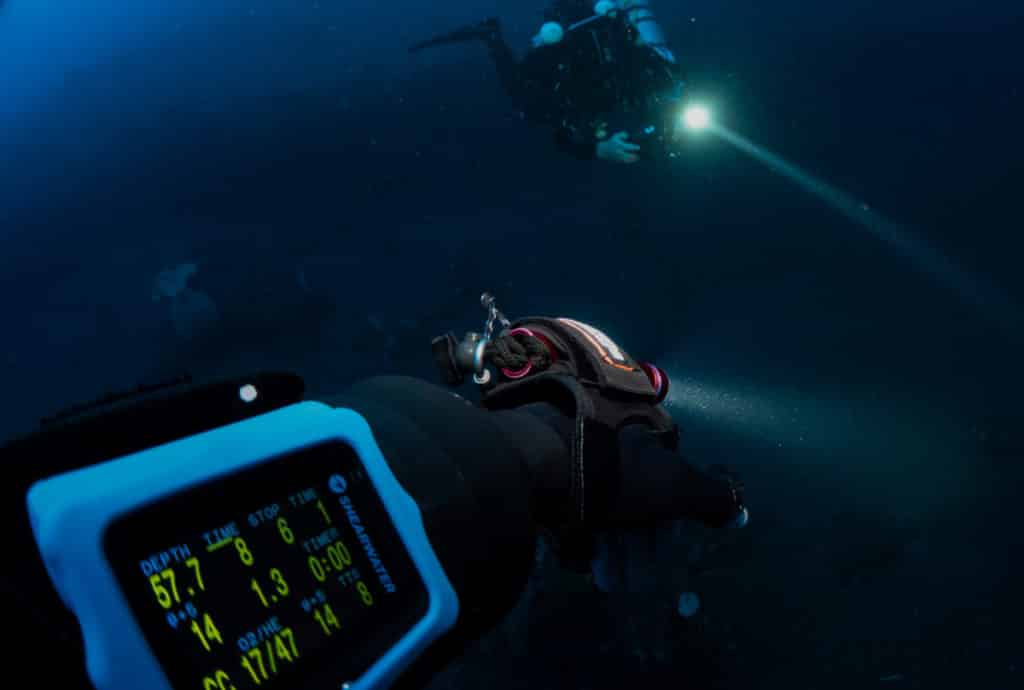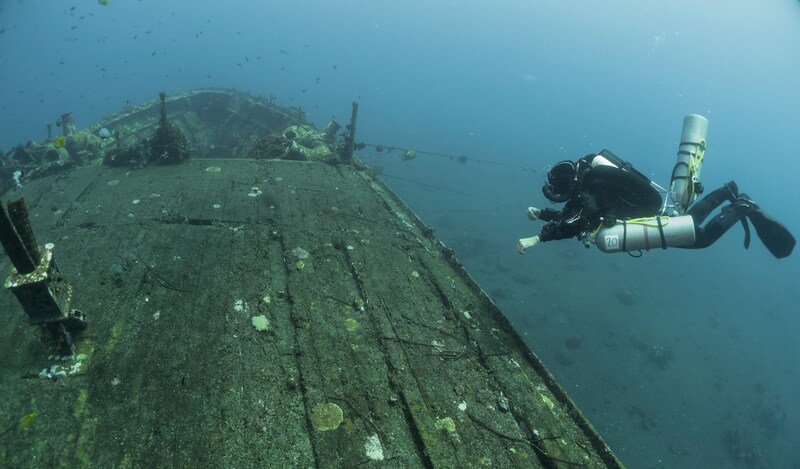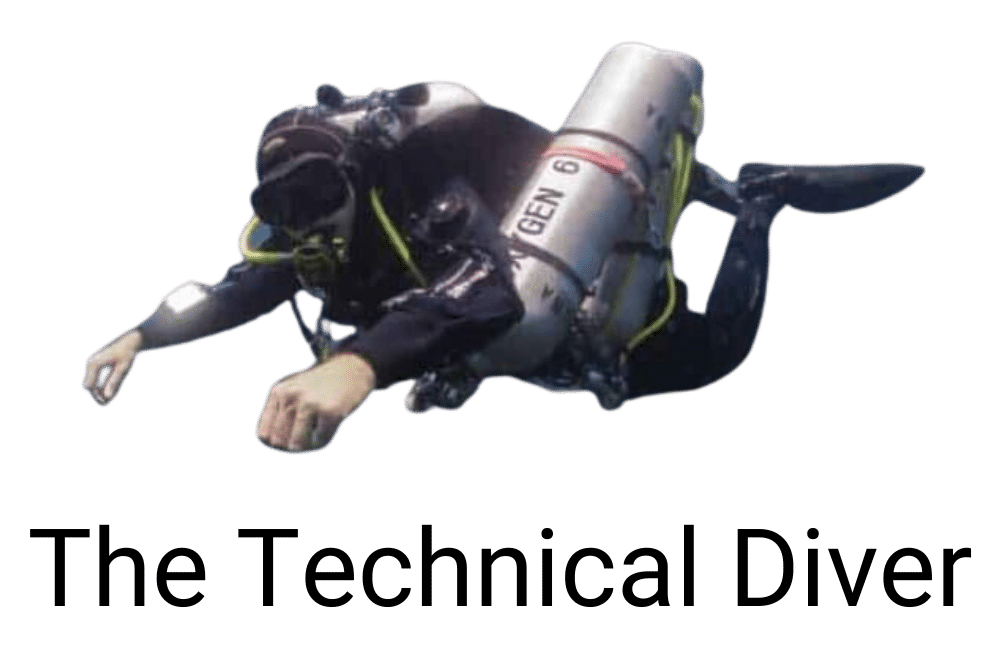Rebreather Diving

Rebreather Diving
Deciding whether to become a rebreather diver is a big decision. Rebreathers cost a lot of money, and competence is often a long slow road. Plus, taking them on holiday can be a pain.
But there are great rewards for putting time and energy into rebreather diving. The learning curve becomes fun once the first few hurdles are accomplished. The benefits include longer bottom times, much cheaper trimix dives, and potentially close encounters with marine life.
Travelling with rebreathers
Until as recently as 10 years ago it was not easy to take your rebreather somewhere on holiday. Local shops didn’t have 3L cylinders, there was no virkon or steramine, and sofnolime was impossible to get hold of. Thankfully times have changed and many dive operators can accommodate rebreather divers. Of course, the more remote the location, the less likely they are to provide support. But even places like Truk Lagoon are now equipped for rebreather diving.

What is a rebreather?
Let’s start with the obvious. When you go for a normal dive, as you exhale the air rises to the surface and is lost forever to the environment. That’s why it’s called open-circuit diving. Rebreather diving, or Closed-Circuit-Rebreather diving (CCR) retains your exhalations in a closed system. You recycle the gas by “re-breathing” the same lungful of gas over and over. That gas moves from your lungs to an external bag- so-called counter lungs, and then back into the main part of the rebreather, before reaching your lungs again.
Dalton’s law
Let’s imagine that we are breathing air with the rebreather at the surface. As you inhale, you breathe in 21% oxygen and 78% nitrogen. During respiration, your body will metabolise 4-5% of that oxygen and you exhale carbon dioxide, water vapour, and the nitrogen that you breathed in. So you breathe out 16% oxygen with each breath. If you breathe the same lungful of gas you will become hypoxic and hypercapnic. As you descend, the percentage of the gases stays the same, but the partial pressure of the gases increases. It’s partial pressure that is used to track oxygen.
Closed system
To prevent the loop becoming hypoxic, the rebreather has oxygen sensors that analyse the contents of the gas in this closed system, and a solenoid that injects oxygen to maintain a constant set point of oxygen. To prevent hypercapnia, the air passes through a scrubber. This scrubber contains a chemical that removes the carbon dioxide. The most common brand is called sofnolime, which is a mixture of calcium hydroxide and sodium hydroxide.
Attached to the rebreather are two cylinders. One contains 100% oxygen and the other is a “diluent” gas. The solenoid injects oxygen directly from the oxygen cylinder. Diluent is injected into the loop to help maintain “optimum loop volume” or to dilute the oxygen percentage in the loop. As you descend, atmospheric pressure reduces the volume of the gas in the counter lungs, the same as with a BC. To take a full breath in, more gas must be added to the loop.
Partial pressures and setpoints
During descent, diluent must be added to provide a sufficient volume of gas to breathe. Oxygen is not added into the loop during descent, because the increased hydrostatic pressure of the water will cause the Partial Pressure of Oxygen (PPO2 or PO2) to rise.
You can also manually add diluent into the loop to do what we call a diluent flush. You may do this because you descended too quickly and the PO2 rose too much. Diluent gas should always be appropriate for the dive you are doing. For deeper dives, it may contain normoxic or hypoxic trimix instead of air.
During an ascent, the PO2 in the loop reduces, so either you or the rebreather (or both) need to add oxygen to maintain the required setpoint. There are different ways to do this, you may have the setpoint at 1.2 or 1.3. In this case, the solenoid will be actively adding oxygen during the ascent to try and maintain that setpoint. This can be tricky to manage as it feels like the solenoid is a little trigger happy. I prefer to lower the setpoint to 0.7 and manually add O2 to maintain my desired setpoint. Changing the setpoint to 0.7 will stop the solenoid from firing (as long as it is above 0.7 in the loop), so I can be in control of adding oxygen.
Managing gas when rebreather diving
Rebreathers can be difficult to learn because it takes a while to understand how they work, and even longer to absorb how to operate them. There are three sets of gas to have to deal with- the drysuit, the BC, and the loop. Descending is relatively straightforward, but ascents can be task-loading. During an ascent you need to let excess gas out of the drysuit and BC, and also the loop. Remember that PO2 drops during ascents due to the reduction in atmospheric pressure, so whilst breathing out through the nose to vent some of the loop gas, either you or the solenoid will be adding more oxygen in to maintain the desired setpoint.
So initially, rebreather diving can be 1 step forward and 2 steps back. It’s also counterintuitive because breathing in and out does nothing to change buoyancy like it does with open circuit diving.
Whilst rebreathers can allow for longer bottom times and more efficient decompression, they are limited by how long the scrubber lasts, and how much open circuit gas you can carry- In an emergency you may need to get off the rebreather by “bailing out”, so separate cylinders must be carried that will allow you to complete the rest of your deco on open circuit to get you to the surface safely.
Rebreather types
Rebreathers come in different forms, there are ECCRs- Electronic Closed Circuit Rebreathers. This means that the computer electronics handle everything regarding maintaining setpoint, with the option to manually add O2 and diluent. MCCRs- manual Closed Circuit Rebreathers have a so-called constant mass flow orifice, that can be finely tuned to inject a constant flow of oxygen into the loop. How much oxygen is injected will depend on how much O2 you are metabolising, so your work rate is the main influence in this. They are also called Diver Controlled Closed Circuit Rebreathers (DCCCRs).
There are also Semi-Closed Circuit Rebreathers available (SCCRs). These usually add a mixture of nitrox into the loop instead of oxygen and are designed to purge automatically at set intervals before injecting again. This uses a lot of gas, but the trade-off is that there is generally less risk of the oxygen content accidentally becoming too high.
For more information on how rebreathers work, AP Diving has made some good videos that you can view here.
How can you learn rebreather diving?
Most dive resorts that offer technical diving also offer rebreather training. The instructors that teach it may teach only one unit, or perhaps a couple of different units. Some will have units to rent for the course, but this is not recommended. If you don’t regularly dive on a rebreather, you get rusty fast, and this is when accidents are more likely to happen.
It’s much more appropriate that you undertake open circuit technical training, and then when you think you want to make the jump, do some try dives on different units. Talk to instructors on the brand that they teach on and ask about the pros and cons. There is no perfect rebreather out there, they all have pluses and minuses. Spend time reading about them.
Open circuit training before rebreather training
Why did I say that you should undertake open circuit technical training before jumping onto a rebreather. Surely it would be much cheaper to just go straight to CCR? Yes it would. But you will find it very challenging. Think about it. You will learn about the equipment configuration, how the rebreather works and everything else associated with CCR diving. But you’ll also learn and practice technical diving fundamentals and decompression diving at the same time. That’s a hell of a lot to take it. If you have experience of decompression diving, you can focus your energy on learning how the rebreather works during the CCR course.
If you know of any good resources for rebreather diving that aren’t on this website, I’d be grateful if you could let me know so I can add them. Contact me here.
Header image photo credit: Tony Wong
